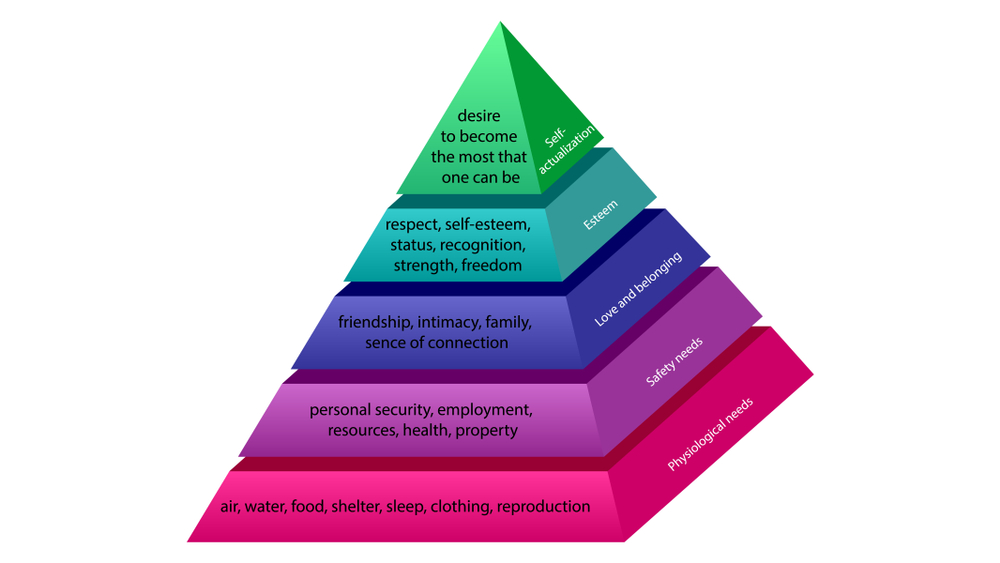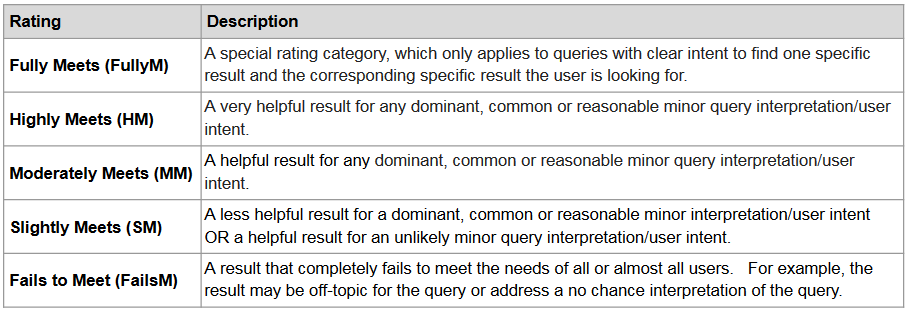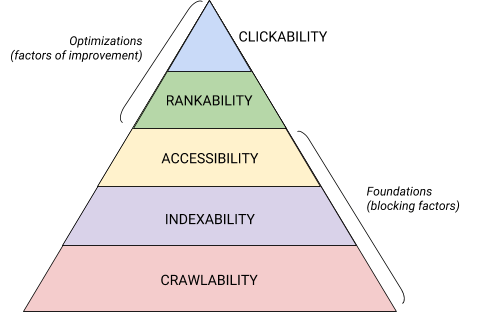Maslow’s pyramid, the theory of needs applied to the website and SEO
It is a psychological model that has spanned decades and continues to be a benchmark not only in the field of psychology, but also in the field of marketing and human resource management, because its application goes beyond simply understanding human needs and offers insights for communication strategies and brand positioning that aim to connect with audiences at a deeper level. Maslow’s pyramid is one of the most famous theories in the field of communication: first devised in psychology to refer to essential human needs, the structure devised by the American psychologist can be applied to digital marketing and also provides fundamental guidance for SEO, especially when we talk about search intent. Not to mention that Google also asks its quality raters to focus on user needs (Needs Met) and the ability of pages to meet them while fulfilling the purpose for which they are created.
What Maslow’s Pyramid is
Maslow’s Pyramid is a conceptual model that organizes human needs into a five-level hierarchical structure.
Synthesizing to the maximum, at the base we find physiological needs, such as hunger and thirst, followed by security needs, which include stability and protection from danger. Continuing to the apex of the pyramid we encounter social needs, such as belonging and love, followed by the need for esteem, which includes recognition and respect of others. Finally, at the top of the pyramid is self-actualization, which is the desire to realize one’s potential and engage in activities that one feels are deeply meaningful.
The mind behind the famous pyramid is U.S. psychologist Abraham Maslow, who in 1954 published “Motivation and Personality,” a volume destined to establish itself in the field of humanistic psychology, where precisely the explanation of the pyramid of needs, a theoretical model of hierarchy of motivations in human development, appears.
In his theory, needs and motivations have the same meaning and are ranked in degrees ordered according to a precise hierarchical scale, the hierarchy of needs. The logical implication is that it is not possible to reach the needs at the top of the pyramid structure without ensuring that the most basic needs are first met.
The hierarchy and pyramid of needs according to Maslow
Maslow’s training and career developed at a time when psychology was dominated by two main currents: behaviorism and psychoanalysis, from which, however, he broke away from these views and proposed a new perspective that emphasized the importance of the pursuit of happiness and individual well-being. This approach, known as humanistic psychology, emphasizes the human capacity for self-realization and the need for an environment conducive to personal growth.
Always meet search intent and readers’ needs
For this reason, at the base of Maslow’s pyramid are the primary and physiological needs, which are essential for the survival of the individual, and rising to the top are the higher motivations and intangible needs (psychological and spiritual), which enable the full realization of one’s human potential, a process defined as self-realization.
The meaning of Maslow’s pyramid
The pyramid is not only a representation of human needs, but it is also a model that explains how these needs influence our behavior: according to Maslow, the lowest needs must be met before we can aspire to higher ones-and this concept has profound implications in marketing and communication, because for example, an advertising message that addresses basic needs will be very different from one that aims to satisfy the desire for self-actualization.
In addition, Maslow’s Pyramid helps us understand the path to personal and professional growth: in human resource management, for example, the model can be used to develop training and incentive programs that address different levels of employee needs, thereby promoting employee satisfaction and productivity.
Maslow’s Pyramid reminds us that each individual is driven by a complex hierarchy of needs and motivations, which is (also) why, seventy years later, it remains an influential model. Understanding this structure can be the key to creating effective communication strategies, designing products that meet real needs, and building workplaces that foster well-being and personal growth.
Maslow’s pyramid, the five degrees of needs
Delving deeper into the study and analysis of this hierarchical scale, we start as mentioned with the basic and elementary needs such as feeding, sleeping or drinking: when they are not met, the very survival of the person is at risk. At the second level we find security needs, related to health, work, family, property and social skills, while the next step is social needs, that is, relationships with others that allow the individual to be and feel integrated into a community, to have belonging.
From basic motivations to self-actualization
With the next points we approach the tip of the chart: it is not enough to enter into simple relationships with other people, because the mature individual also needs external esteem and appreciation. The need for esteem is also linked to self-perception and self-esteem, which drives continuous improvement to satisfy oneself and others and to be better off.
On the top of Maslow’s pyramid are the self-actualization needs, which are the rarest and are related to the need to express oneself and one’s nature differently from everyone else, find one’s identity and follow one’s path proudly, based on personal expectations and potential.
Understanding needs to understand the individual
Only the satisfaction of the most basic motivations can allow those of a higher order to emerge in the “hierarchy of needs,” and to study and understand an individual, one must consider him or her as a “totality of needs,” which are common to all even though each person remains unique and unrepeatable. Precisely, needs are one element that unites individuals and enables them to reach a better level of life when they are met, and therefore only the satisfaction of physiological needs can lead to the emergence of higher and “abstract” needs.
Maslow’s pyramid and SEO
Returning to our more classic topics, Maslow’s description of needs and the attention given to the importance of satisfying these motivations comes close to two key concepts for Web sites, namely creating quality content that has a purpose for users (as Google’s Martin Splitt also reminded us about the most important on-page SEO factors) and that intercepts the search intent, which we can define precisely as the need or want to be satisfied that drives the user to use the search engine.
Perform keyword researches focused on user needs
Maslow’s theory can also be a reference for those who own or manage sites and seek to improve performance through SEO, because it suggests a path to understanding the needs that drive user action on search engines.
For this, it is essential to start with a deep and serious analysis of the target audience to understand what needs and requirements they feel and, in parallel, study the SERPs and how Google interprets their queries.
This is the only way to understand what the search intent is, the driving force behind a Google search, and only by knowing it can you create content that intercepts and satisfies it. Search intent can and should condition the choice of type of content and communication over others, because it is the key to connecting with people: to give a trivial example, if the query is transactional you cannot expect to rank with an informative article, because people want to buy.
From theory to practice: keyword research and intent-based content
Thus, the need to consider keyword research not a simple search for attractive keywords or a list of words, but an activity that investigates the interests and needs of users, i.e., people who have needs and want to satisfy them, becomes central again.
Don’t lose your focus
At SEOZoom, we have the right tools to do this strategic keyword research, which can help fine-tune on-page content that really offers added value to the user, which therefore has a purpose that is not (only) to get a Google ranking, but to try to satisfy the person’s need and help him or her perhaps climb a rung in Maslow’s pyramid of needs.
SEO and needs, Google’s guidance
But needs are also talked about extensively in Google’s Quality Raters Guidelines, the public and frequently updated document (at the moment, the latest version of these Search Quality Raters Guidelines is dated December 19, 2023) that serves to guide the work of quality reviewers in the Google Search system, defining the conditions, parameters and elements to be considered in the evaluation process to determine whether the SERP and page are worthy, useful and effective for users.
Specifically, Part Two of the guidelines focuses precisely on Understanding Search User Needs, basically an invitation to analyze what the person’s intent may be in using Google, the task they are trying to accomplish – while the subsequent Part Three explains what “Needs Satisfaction” or Needs Met means.
Basically, having clear in mind what the user wants to achieve, quality raters have to evaluate whether the pages proposed in SERPs succeed in accompanying the person to reach their goal; it follows, by logic, that therefore Web pages must have a clear purpose.
In Google’s words, the Needs Met rating tasks ask “to focus on user needs and to think about how useful and satisfying the result is for users.” There are five possible rating bands:
- Fully Meets. A special rating category that applies only to certain queries and results. All or most users are immediately and fully satisfied with the result and do not need to view other results to satisfy their needs.
- Highly Meets. Very useful for many or most users. Some users may want to see other results.
- Moderately Meets. Useful for many users or very useful for some users. Some or most users may want to see other results.
- Slightly Meets. Useful for fewer users. There is a link between the question and the result, but it is not strong or satisfactory. Many or most users tend to see other results.
- Fails to Meet. Does not completely meet users’ needs. All or most users tend to see other results.
Page goals
Achieving the satisfaction of user needs also ties in with the broader discussion of the purposes of pages, or “the reason or reasons why the page was created”: in Google’s view, “every page on the Internet is created for a purpose or multiple purposes,” and “most pages are created to be useful to people, so they have a charitable purpose,” although there is no shortage of “pages created just to make money, with no effort to help people” or even “pages created to harm users.”
The most common purposes of a useful or beneficial page are (but not limited to):
- To share information about a topic.
- Sharing personal or social information.
- Sharing images, videos or other forms of media.
- Expressing an opinion or point of view.
- Entertaining.
- Selling products or services.
- Allow users to ask questions that other users can answer.
- Allow users to share files or download software.
Maslow’s Pyramid applied to SEO and the essential needs of a site
Returning then to the applications of Maslow’s Pyramid in the digital sphere, we cannot fail to mention some examples of the “SEO hierarchy of needs” that can help us understand on which areas to prioritize optimization work.
If for humans we start with physiological needs and then move on to more abstract ones, what Maslow’s pyramid has in common for SEO are the technical elements: if we do not have a scannable and indexable site, in fact, all subsequent work is essentially useless or at least invisible to Google.
This version is proposed by biggerlawfirm.com, reworking information from Search Engine Land, and proposes a pyramid structure composed as follows (from base to top):
- Crawlability
Making pages open to scanning by Googlebot and other crawlers is the most basic aspect of SEO, and no mistakes are allowed: the best and most expensive site on the Internet is useless if it cannot be found.
- Indexability
Even when a Web site is crawled correctly, some things may prevent it from being indexed, such as the presence of multiple versions of pages, duplicate content, redirects, and so on. As with crawling, if something is not indexed it will not show up on a search engine and will remain invisible and almost unreachable to users.
- Accessibility
Accessibility refers to the ease with which a website can be viewed and used, which must be intuitive for both bots and users. We then enter higher-order needs, which meet additional needs beyond the basic ones.
- Rankability
Rankability is one of the two most advanced and technical levels at the top of the hierarchy of SEO needs and brings us closer to the real topic of SEO optimization and what hinders it.
- Clickability
The final level of the SEO hierarchy is clickability-a highly technical element that involves increasing the likelihood that users will click and interact with a website. Clickability is where technical SEO and online human behavior come together.
Slightly different is the Maslow pyramid devised by Rand Fishkin in his Moz era, and ingeniously renamed Mozlow’s hierarchy of SEO needs.
Here, in fact, seven steps necessary for successful SEO are identified:
- Scan for accessibility so that the engines can read your website.
- Create compelling content that answers the searcher’s question.
- Optimize keywords to attract users and search engines.
- Provide a great user experience (e.g., fast loading speed and compelling user experience).
- Publish shareable content that earns links, citations, and circulation.
- Write title, URL, and description to achieve high CTR in rankings.
- Use snippet/schema markup to stand out in SERPs.






